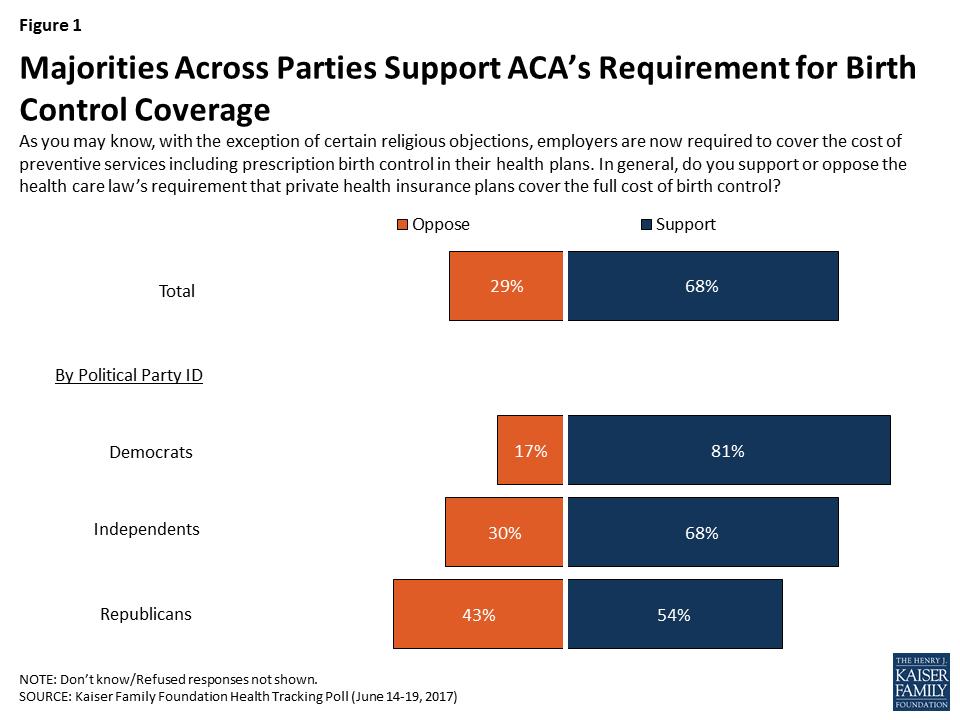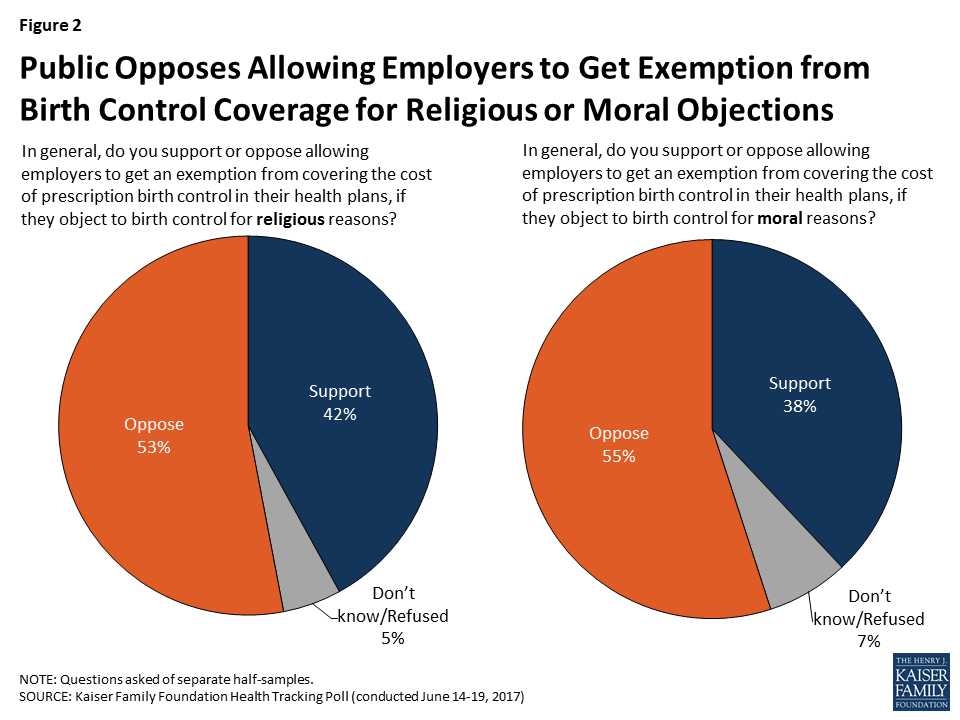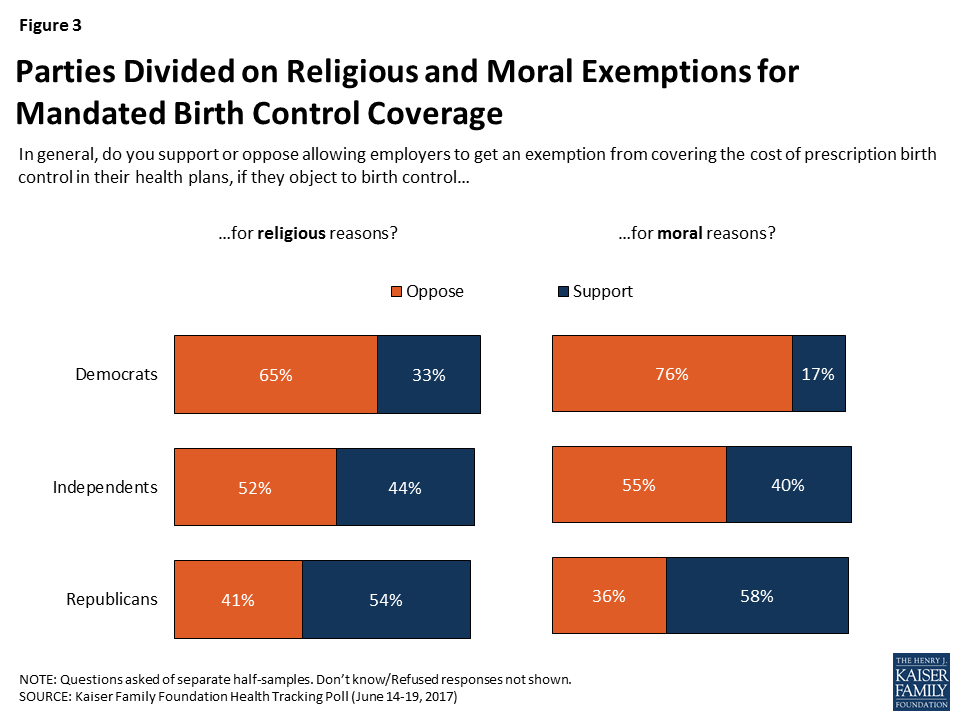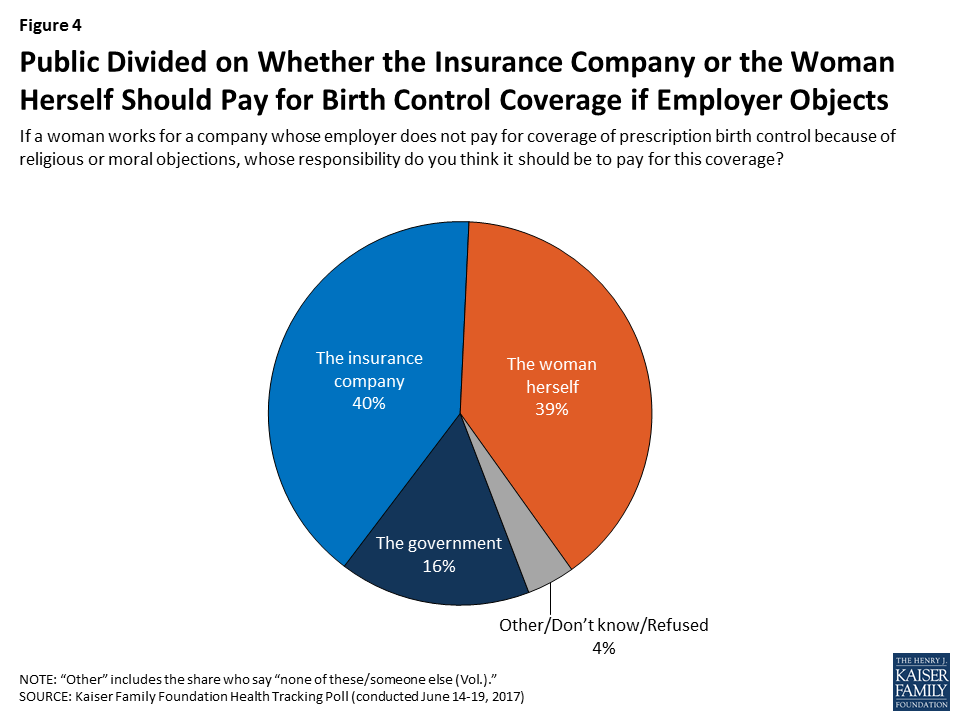Kaiser Health Tracking Poll – June 2017: Women’s Health
Findings
The Affordable Care Act (ACA) requires employers to cover the full cost of prescription birth control as part of their health insurance plans. This section of the June Kaiser Health Tracking Poll finds that a majority of the public (68 percent) support the requirement for private health insurance plans to cover the full cost of birth control. This includes a majority of Democrats (81 percent) and independents (68 percent), as well as 54 percent of Republicans.

Exemptions to Birth Control Requirement for Religious or Moral Reasons
In 2014, the Supreme Court of the United States issued their decision in Hobby Lobby v. Burwell which established that “closely held” for-profit corporations could be exempt from the birth control requirement if their owners had religious objections. Recently, there has been a suggestion that the Trump administration could expand this exemption to include a broader group of employers who object to birth control for either religious or moral reasons. Overall, larger shares of the public oppose rather than support allowing employers to get an exemption from covering the full cost of prescription birth control for either religious (53 percent vs. 42 percent) or moral (55 percent vs. 38 percent) reasons. There is no difference in attitudes depending on whether the exemption is for “religious” or “moral” reasons.

There are strong partisan differences on this issue. A majority of Democrats oppose allowing employers to get exemptions for religious reasons (65 percent) and moral reasons (76 percent). On the other hand, more than half of Republicans support allowing employers to get an exemption if they object to birth control for religious reasons (54 percent) or moral reasons (58 percent). Independents are more divided than partisans but lean toward opposition with about half opposing exemptions to the requirement for religious (52 percent) or moral (55 percent) reasons.

Public Divided on Who Covers Birth Control Costs if Employer Gets Exemption
If an employer receives an exemption from covering the cost of prescription birth control due to either religious or moral reasons, the public is divided on who should be responsible for picking up those costs with similar shares saying it is the responsibility of the insurance company (40 percent) as say it is the responsibility of the woman herself (39 percent). Fewer (16 percent) say it is the government’s responsibility.

Differences by Gender Dependent on Party Identification
Majorities of female Democrats and female independents say that if an employer gets an exemption from covering the cost of birth control it should be the responsibility of the insurance company to pay (57 percent and 54 percent, respectively) while six in ten female Republicans (62 percent) say it should be the responsibility of the woman herself. Among men, a majority of male Republicans (65 percent) say it is the responsibility of the woman herself, while male Democrats and male independents are more divided. Half of male independents say it is the responsibility of the woman herself while half of male Democrats (48 percent) say it is the responsibility of the insurance company.
| Table 1: Perceptions of Responsibility Driven by Gender, Party Identification | ||||||
| Percent who say if a woman works for a company that does not pay for birth control coverage, the following should be responsible to pay: | Male | Female | ||||
| Dem | Ind | Rep | Dem | Ind | Rep | |
| The insurance company | 48% | 32% | 25% | 57% | 54% | 24% |
| The woman herself | 25 | 50 | 65 | 14 | 31 | 62 |
| The government | 22 | 14 | 8 | 25 | 13 | 10 |
| None of these/Someone else (vol.)/Don’t know/Refused | 5 | 5 | 2 | 4 | 2 | 4 |
Methodology
This Kaiser Health Tracking Poll was designed and analyzed by public opinion researchers at the Kaiser Family Foundation (KFF). The survey was conducted June 14-19, 2017, among a nationally representative random digit dial telephone sample of 1,208 adults ages 18 and older, living in the United States, including Alaska and Hawaii (note: persons without a telephone could not be included in the random selection process). Computer-assisted telephone interviews conducted by landline (427) and cell phone (781, including 483 who had no landline telephone) were carried out in English and Spanish by SSRS of Glen Mills, PA. Both the random digit dial landline and cell phone samples were provided by Marketing Systems Group (MSG) of Horsham, PA. For the landline sample, respondents were selected by asking for the youngest adult male or female currently at home based on a random rotation. If no one of that gender was available, interviewers asked to speak with the youngest adult of the opposite gender. For the cell phone sample, interviews were conducted with the adult who answered the phone. KFF paid for all costs associated with the survey.
The combined landline and cell phone sample was weighted to balance the sample demographics to match estimates for the national population using data from the Census Bureau’s 2015 American Community Survey (ACS) on sex, age, education, race, Hispanic origin, and region along with data from the 2010 Census on population density. The sample was also weighted to match current patterns of telephone use using data from the July-December 2016 National Health Interview Survey. The weight takes into account the fact that respondents with both a landline and cell phone have a higher probability of selection in the combined sample and also adjusts for the household size for the landline sample. All statistical tests of significance account for the effect of weighting.
The margin of sampling error including the design effect for the full sample is plus or minus 3 percentage points. Numbers of respondents and margins of sampling error for key subgroups are shown in the table below. For results based on other subgroups, the margin of sampling error may be higher. Sample sizes and margins of sampling error for other subgroups are available by request. Note that sampling error is only one of many potential sources of error in this or any other public opinion poll. Kaiser Family Foundation public opinion and survey research is a charter member of the Transparency Initiative of the American Association for Public Opinion Research.
| Group | N (unweighted) | M.O.S.E. |
| Total | 1208 | ±3 percentage points |
| Party Identification | ||
| Democrats | 385 | ±6 percentage points |
| Republicans | 311 | ±7 percentage points |
| Independents | 407 | ±6 percentage points |
| Trump Approval | ||
| Approve of President Trump | 487 | ±5 percentage points |
| Disapprove of President Trump | 672 | ±4 percentage points |
| Half Sample | ||
| Sample A | 597 | ±5 percentage points |
| Sample B | 611 | ±5 percentage points |